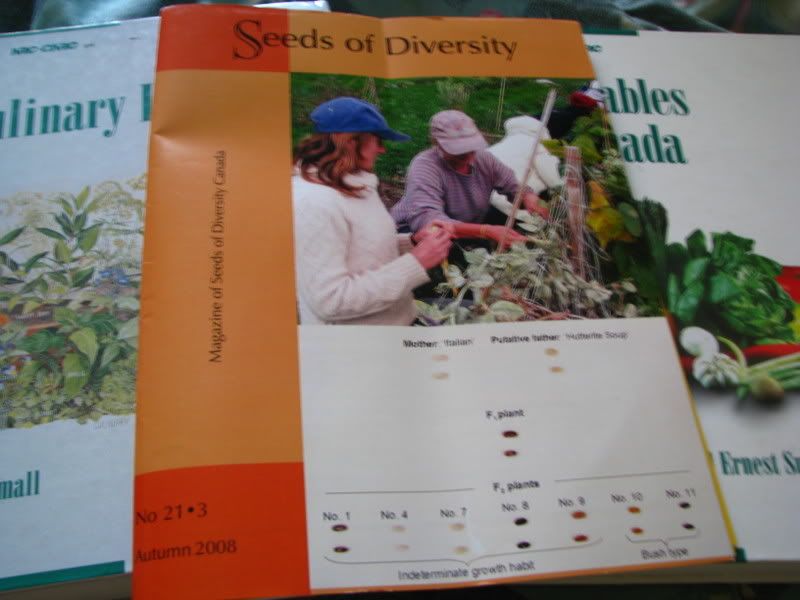Before I start, let it be stated that I approve of this trend! OK, now you can read on.
***
Seeds of Diversity mag perched atop my favourite read of the moment. NRC (National Research Centre)'spublications Herbs of Canada and Vegetables of Canada.
If you want to be part of the ultracool organic, edible plant geeks this summer, then you have to do more than just save your seeds. Seed strain purity is good but if you really want to wow your friends and impress your neighbours, then a melon variety named after you is even better.
All kidding aside, I have noticed that there has been more and more talk about amateur plant breeding amoung seed savers. Perhaps it's just a natural progression. First you learn how to define OP and heirloom (let me know when you figure the exact definition of this btw). Then you get up the nerve to save more than just bean seeds. Next thing you know you are wondering if you can develop a purple podded snap pea or an early gold cherry tomato or, if your addiction has gone far enough, a perennial grain or a wide cross between two plant cousins. You have joined the ranks of the amateur plant breeders.
Even the cover of the latest Seeds of Diversity (great resource for gardeners/seed sharers/savers - check out their Canadian Tomato project) highlights this growing interest by featuring a generational digram of bean seeds. In this you see that the 'plant breeder' is not sure of the 'father' of his cross. Which brings me to the more haphazard version of plant crossing called 'accidental.' Of course, in the article he details and follows the accidental cross in a well planned manner.
I would describe myself as a more or less lazy plant breeder. I like to buy mixed seed packs of plants like mustard or beets and let them cross in my garden*. After awhile, I will then start to select my favourite outcomes of the cross and eventually (one hopes) get a strain of beets or whatever that I like. They may not be uniform and there might be a lot of rouging (getting rid of) inadequate varieties but I enjoy the variation. I also feel that the wider genetic variation will allow for yearly differences in pests, conditions and so on. Before any 'professional' amateur plant breeders read this and tsk-tsk my technique (if you can call it that), there are a lot of details that I have decided not to go into in this post just to keep the length down and to not bore to death those that haven't been overtaken by plant manipulation fever.**
It is also a bit inaccurate to call this a new trend. People have been selecting, intentionally or not, for improved edibles for as long as we have been eating. Just think of our ancestors choosing one fruit over another and then depositing the seeds in our 'special compost' near our dwellings perhaps even in clearings. Those seeds would get fertilizer and potentially more light. Then as we liked those fruit, we might have decided to weed around it a bit giving it all the more advantage and then eat the result etc... It just got more sophisticated from there.
This 'new' trend is reclaiming an art lost to many gardeners. A knowledge of genetics makes it less haphazard (ie. not my technique) and even more fun. For more on amateur plant breeding, genetics and techniques, I highly recommend Carol Deppe's book Breed Your Own Vegetable Varieties.
* If I offer seed varieities, I do try my best to ensure seed purity. In the furture, I might offer mixed seed but do you really want it?
** Seed saving is essentially plant selection which is why it is a good idea to know a little about plant genetics to avoid disappointment in future plantings.
*** I know I didn't have a third footnote? Don't let this scare you off seed saving, however, it is great fun.
**** Also a member of a plant breeders forum that seems to be based around a seed development company has recently left his url on my blog. If you are a plant breeder geek, you might be interestd in http://alanbishop.proboards60.com/index.cgi


3 comments:
First off thanks for stopping by my blog today. Very interesting post today about selecting seed for a new cultivar. I haven't purposely done this but have had some plants crossbreed & create something new & unique.
Thanks for giving out some promotion for the homegrown goodness forum friend! Much appreciated. Keep up the great blog, I love reading more stuff like what is presented on your blog, it makes winter worthwhile.
http://homegrowngoodness.blogspot.com
I completely agree with everything you say here! There was a time when all gardeners selected and improved their own varieties but we've got so used to buying them ready-made we've forgotten there ever was an alternative.
There's nothing wrong with your 'haphazard' method either. You don't need any knowledge of genetics at all. Genes were only really discovered 100 years ago but it didn't stop people developing new varieties for the 11,000 years or so before that. As you say, the genetic diversity you get from a mix-it-all-up approach is very healthy, and may reward you with some amazing surprises!
Post a Comment